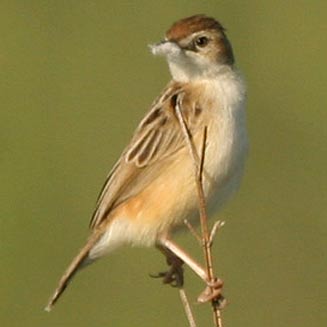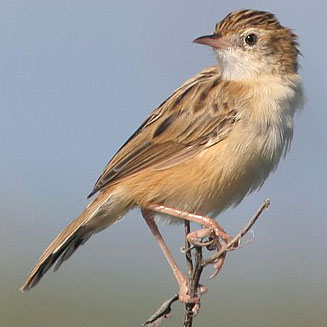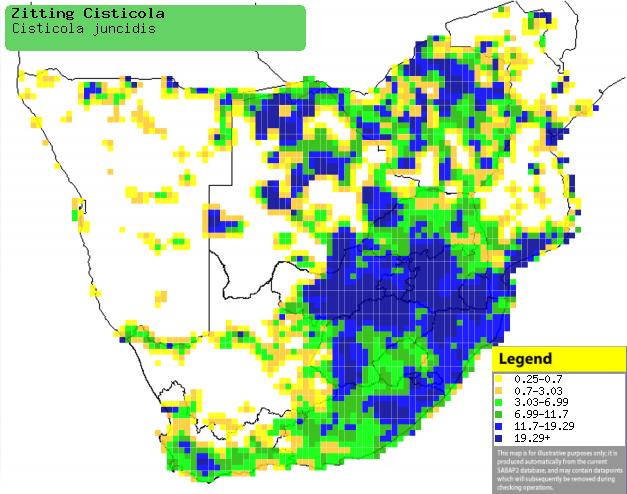|
Cisticola juncidis (Zitting
cisticola, Fan-tailed cisticola)
Landeryklopkloppie [Afrikaans]; Unonzwi [Xhosa]; uNcede
[Zulu]; Motintinyane (generic term for cisticolas and prinias) [South Sotho];
Tangtang [North Sotho]; Kadhi-idhi-i, Timba (generic names for cisticola) [Shona];
Matinti (generic term for cisticola) [Tsonga]; Graszanger [Dutch]; Cisticole des
joncs [French]; Zistensänger [German]; Fuinha-dos-juncos [Portuguese]
Life
> Eukaryotes >
Opisthokonta
> Metazoa (animals) >
Bilateria >
Deuterostomia > Chordata >
Craniata > Vertebrata (vertebrates) > Gnathostomata (jawed
vertebrates) > Teleostomi (teleost fish) > Osteichthyes (bony fish) > Class:
Sarcopterygii (lobe-finned
fish) > Stegocephalia (terrestrial
vertebrates) > Tetrapoda
(four-legged vertebrates) > Reptiliomorpha > Amniota >
Reptilia (reptiles) >
Romeriida > Diapsida > Archosauromorpha > Archosauria >
Dinosauria
(dinosaurs) > Saurischia > Theropoda (bipedal predatory dinosaurs) >
Coelurosauria > Maniraptora > Aves
(birds) >
Order: Passeriformes > Family: Cisticolidae
> Genus: Cisticola
 |
 |
|
Zitting cisticola. [photo
Neil Gray
©] |
Zitting cisticola, Strandfontein Sewage Works,
South Africa. [photo
Trevor Hardaker ©] |
Distribution and habitat
It is extremely widespread, occurring from southern Eurasia
to northern Australia and sub-Saharan Africa, all the way down to southern
Africa. Here it is common to very common in both open and seasonally flooded
grassland, grassy wetlands with little or no drainage and a variety of man-made
habitats, including croplands, golf courses and gardens.
|
 |
|
Distribution of Zitting cisticola in southern Africa,
based on statistical smoothing of the records from first SA Bird Atlas
Project (©
Animal Demography unit, University of
Cape Town; smoothing by Birgit Erni and Francesca Little). Colours range
from dark blue (most common) through to yellow (least common).
See here for the latest distribution
from the SABAP2. |
Food
It eats insects (mostly grasshoppers), doing most of its
foraging low down, gleaning prey from the bases of grass tufts and the bare soil. The following food items have been recorded
in its diet in Europe:
Breeding
- The nest is a unique pear shape with a side entrance, built of spider web
and plant down woven into a framework of the tuft of green grass in which it
is typically placed. The male builds an outer framework and, if approved by
the female, continues to finish it; the whole process usually takes about
12-17 days. If the female does not like the look of it, he often destroys it
and recycles the material to build another one. Once the eggs are laid, the
female adds a lining to the interior during incubation.
- Egg-laying season is from August-April, peaking from November-February.
- It lays 2-5 eggs, which are incubated solely by the female for about
12-15 days.
- The chicks are mainly fed by the female, leaving the nest after about
11-15 days.
Threats
Not threatened.
References
-
Hockey PAR, Dean WRJ and Ryan PG 2005. Roberts
- Birds of southern Africa, VIIth ed. The Trustees of the John Voelcker
Bird Book Fund, Cape Town.
|
